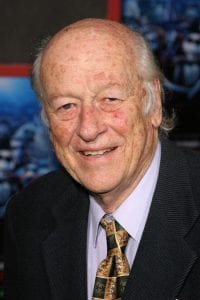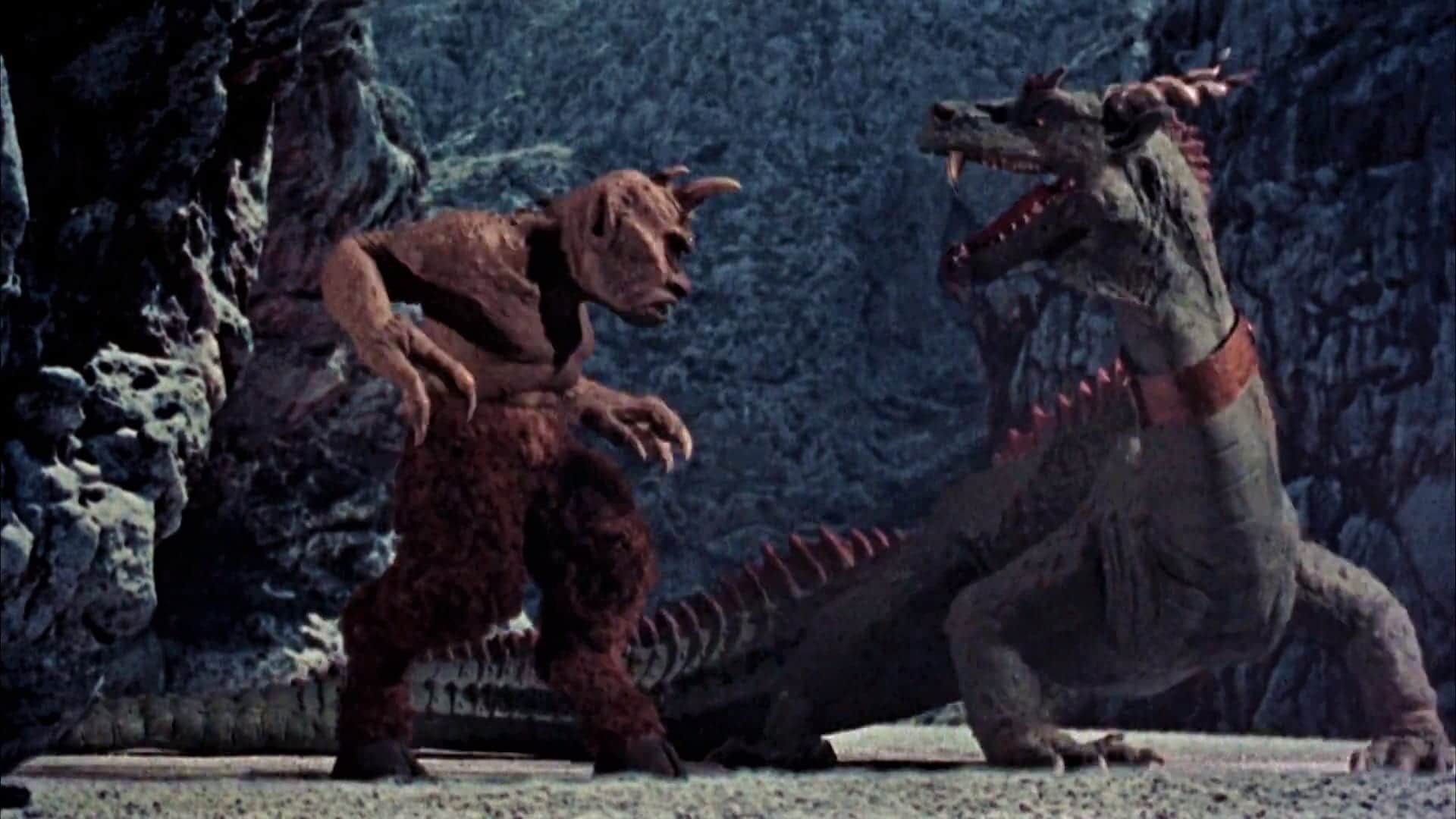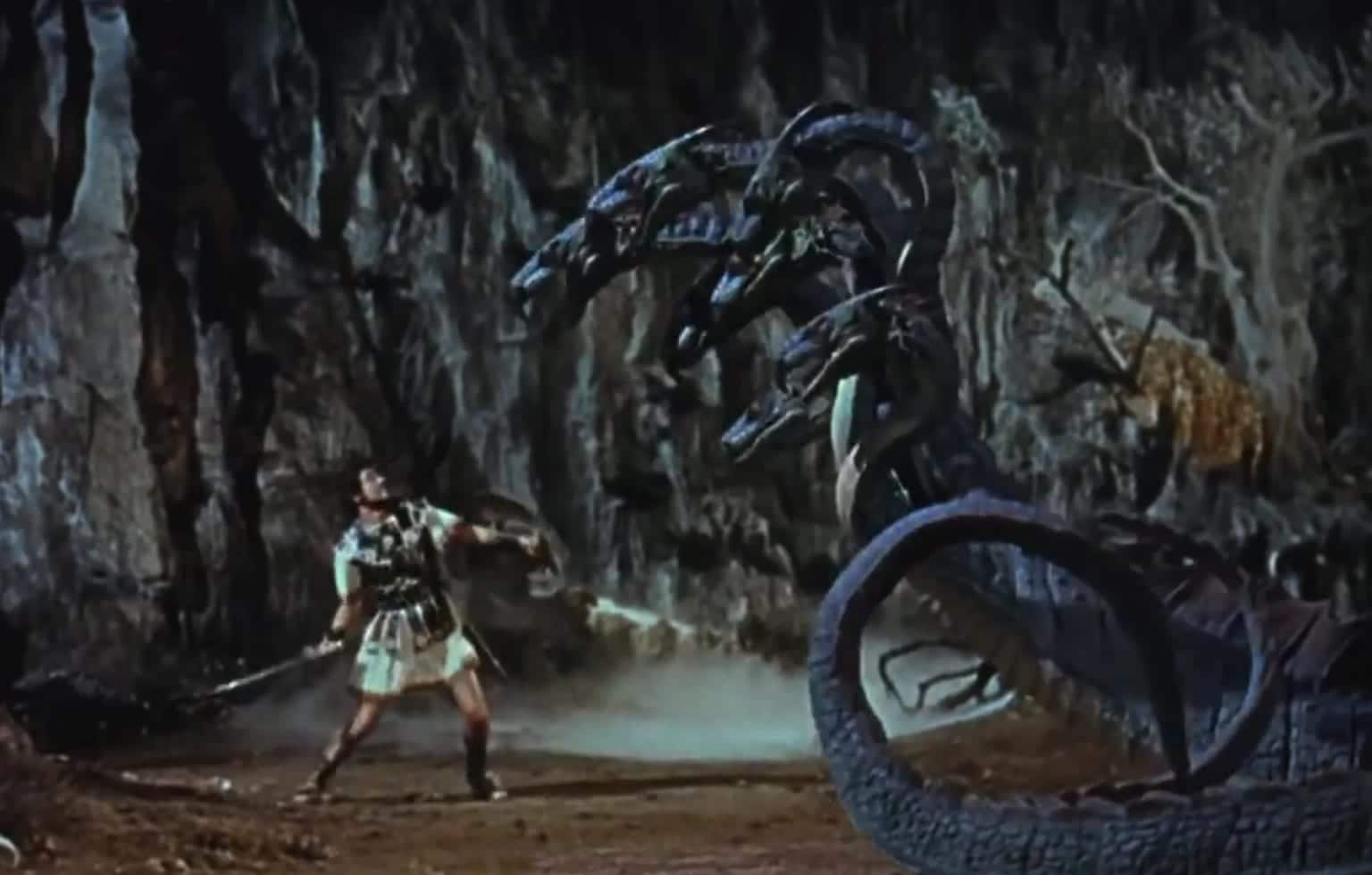Fantasy film maker Ray Harryhausen would be 100 years old today, Monday, June 29, 2020, and Turner Classic Movies has an all-day tribute planned.

Starting at 8 pm ET on Monday, June 29, 2020, TCM will broadcast five of Harryhausen’s classics:
The Seventh Voyage of Sinbad (1958) at 8 pm ET
Earth vs. the Flying Saucers (1956) at 10 pm
Mysterious Island (1961) at 11:30 pm
Mighty Joe Young (1949) at 1:30 am
Clash of the Titans (1981) at 3:30 am
You can find more information at: TCM Ray Harryhausen Tribute
The schedule for the day is: TCM Schedule for June 29
What many fans consider Harryhausen’s masterwork, Jason and the Argonauts, is not included in the TCM tribute but you can rent or buy it from Amazon or Youtube.
Below is a preview of the first film in the TCM Tribute, The Seventh Voyage of Sinbad.
Ray Harryhausen’s Life (from Wikipedia)
Raymond Frederick Harryhausen (June 29, 1920 – May 7, 2013) was an American artist, designer, visual effects creator, writer and producer who created a form of stop-motion model animation known as “Dynamation”.
His works include the animation for Mighty Joe Young (1949), with his mentor Willis H. O’Brien, for which he won the Academy Award for Best Visual Effects; his first color film, The 7th Voyage of Sinbad (1958); and Jason and the Argonauts (1963), which featured a sword fight with seven skeleton warriors. His last film was Clash of the Titans (1981), after which he retired.
Harryhausen moved to the United Kingdom, became a dual U.S.-U.K. citizen and lived in London from 1960 until his death in 2013. During his life, his innovative style of special effects in films inspired numerous filmmakers.
Harryhausen was born in Los Angeles, California, the son of Martha L. (née Reske) and Frederick W. Harryhausen. Of German descent, the family surname was originally spelled “Herrenhausen”.
Life and career
After having seen King Kong (1933) on its initial release for the first of many times, Harryhausen spent his early years experimenting in the production of animated shorts, inspired by the burgeoning science fiction literary genre of the period. The scenes utilising stop-motion animation (or model animation), those featuring creatures on the island or Kong, were the work of pioneer model animator Willis O’Brien.
His work in King Kong inspired Harryhausen, and a friend arranged a meeting with O’Brien for him. O’Brien critiqued Harryhausen’s early models and urged him to take classes in graphic arts and sculpture to hone his skills. Meanwhile, Harryhausen became friends with an aspiring writer, Ray Bradbury, with similar enthusiasms. Bradbury and Harryhausen joined the Los Angeles-area Science Fiction League formed by Forrest J. Ackerman in 1939, and the three became lifelong friends.
Harryhausen secured his first commercial model-animation job, on George Pal’s Puppetoons shorts, based on viewing his first formal demo reel of fighting dinosaurs from a project called Evolution of the World, which was never finished.
During World War II, Harryhausen served in the United States Army Special Services Division under Colonel Frank Capra, as a loader, clapper boy, gofer and later camera assistant, whilst working at home animating short films about the use and development of military equipment.
In 1947, Harryhausen was hired as an assistant animator on what turned out to be his first major film, Mighty Joe Young (1949).
The first film with Ray Harryhausen in full charge of technical effects was The Beast from 20,000 Fathoms (1953) which began development under the working title Monster From the Sea. The filmmakers learned that a long-time friend of Harryhausen, writer Ray Bradbury, had sold a short story called “The Beast from 20,000 Fathoms” (later re-titled “The Fog Horn“) to The Saturday Evening Post, about a dinosaur drawn to a lone lighthouse by its foghorn. Because the story for Harryhausen’s film featured a similar scene, the film studio bought the rights to Bradbury’s story to avoid any potential legal problems. Also, the title was changed back to The Beast from 20,000 Fathoms. Under that title, it became Harryhausen’s first solo feature film effort, and a major international box-office hit for Warner Brothers.
It was on The Beast From 20,000 Fathoms that Harryhausen first used a technique he created called “Dynamation” that split the background and foreground of pre-shot live action footage into two separate images into which he would animate a model or models, seemingly integrating the live-action with the models. The background would be used as a miniature rear-screen with his models animated in front of it, re-photographed with an animation-capable camera to combine those two elements together, the foreground element matted out to leave a black space. Then the film was rewound, and everything except the foreground element matted out so that the foreground element would now photograph in the previously blacked out area. This created the effect that the animated model was “sandwiched” in between the two live action elements, right into the final live action scene.

A few years later, when Harryhausen began working with color film to make The 7th Voyage of Sinbad, he experimented extensively with color film stocks to overcome the color-balance-shift problems. Ray’s producer/partner Charles H. Schneer coined the word Dynamation as a “merchandising term” (modifying it to “SuperDynaMation” and then “Dynarama” for some subsequent films).
Harryhausen was always heavily involved in the pre-production conceptualizing of each film’s story, script development, art-direction, design, storyboards, and general tone of his films, as much as any auteur director would have on any other film, which any “director” of Harryhausen’s films had to understand and agree to work under. The complexities of the Directors Guild of America’s rules prevented Harryhausen from being credited as the director of his films, resulting in the more modest credits he had in most of his films.
Harryhausen soon met and began a fruitful partnership with producer Charles H. Schneer of Columbia Pictures. Their first tandem project was It Came from Beneath the Sea (a.k.a. Monster from Beneath the Sea, 1955), about a giant octopus attacking San Francisco. It was a box-office success, quickly followed by Earth vs. the Flying Saucers (1956), set in Washington D.C. – one of the best of the alien invasion films of the 1950s, and also a box office hit.
Harryhausen then returned to Columbia and Charles Schneer to make 20 Million Miles to Earth (1957), about an American spaceship returning from Venus. The spaceship crashes into the sea near Sicily, releasing an on-board alien egg specimen which washes up on shore. The egg soon hatches a creature that, in Earth’s atmosphere, rapidly grows to gigantic size and terrifies the citizens of Rome. Harryhausen refined and improved his already-considerable ability at establishing emotional characterizations in the face of his Venusian Ymir model, creating yet another international box office hit.
After The 3 Worlds of Gulliver (1960) and Mysterious Island (1961), both great artistic and technical successes, and successful at the box office. His next film is considered by film historians and fans as Harryhausen’s masterwork, Jason and the Argonauts (1963). Among the film’s several celebrated animation sequences is an extended fight between three actors and seven living skeletons, a considerable advance on the single-skeleton fight scene in Sinbad. This stop-motion sequence took over four months to complete.

Harryhausen next made First Men in the Moon (1964), his only film made in the 2.35:1 widescreen (a.k.a. “CinemaScope”) format, based on the novel by H. G. Wells.
Harryhausen was hired by Hammer Films to animate the dinosaurs for One Million Years B.C. (1966). It was a success at the box office, helped in part by the presence of Raquel Welch in her second film. Harryhausen next went on to make another dinosaur film, The Valley of Gwangi. It was a personal project to Harryhausen, which he had wanted to do for many years, as it was storyboarded by his original mentor, Willis O’Brien for a 1939 film, Gwangi, that was never completed. Set in Mexico, The Valley of Gwangi is a parallel Kong story—cowboys capture a living Allosaurus and bring him to the nearest Mexican town for exhibition.
After a few lean years, Harryhausen and Schneer talked Columbia Pictures into reviving the Sinbad character, resulting in The Golden Voyage of Sinbad, often remembered for the sword fight involving a statue of the six-armed Hindu goddess Kali. It was first released in Los Angeles in the Christmas season of 1973, but garnered its main audience in the spring and summer of 1974. It was followed by Sinbad and the Eye of the Tiger (1977), which disappointed some fans because of its tongue-in-cheek approach. Both films were, however, box office successes.[citation needed]
Schneer and Harryhausen finally were allowed by MGM to produce a big budget film with name actors and an expanded effects budget. The film started out smaller, but then MGM increased the budget to hire stars such as Laurence Olivier. It became the last feature film to showcase his effects work, Clash of the Titans (1981), for which he was nominated for a Saturn Award for Best Special Effects. For this film, he hired protégé model animators Steve Archer and two-time Oscar-nominated Jim Danforth to assist with major animation sequences. Harryhausen fans will readily discern that the armed-and-finned Kraken (a name borrowed from medieval Scandinavian folklore) he invented for Clash of the Titans has similar facial qualities to the Venusian Ymir he created 25 years earlier for 20 Million Miles to Earth.
Perhaps because of his hermetic production style and the fact that he produced half of his films outside of Hollywood (living in London since 1960), reducing his day-to-day kinship with other more traditional, but still influential Hollywood effects artists, none of Harryhausen’s films were nominated for a special effects Oscar. Harryhausen himself says the reason was that he worked in Europe, but this oversight by the AMPAS visual-effects committee also occurred throughout the 1950s when Harryhausen lived in Los Angeles.[citation needed]
In spite of the very successful box office returns of Clash of the Titans, more sophisticated computer-assisted technology developed by ILM and others began to eclipse Harryhausen’s production techniques, and so MGM and other studios passed on funding his planned sequel, Force of the Trojans, causing Harryhausen and Schneer to retire from active filmmaking.
In the early 1970s, Harryhausen had also concentrated his efforts on authoring a book, Film Fantasy Scrapbook (produced in three editions as his last three films were released) and supervising the restoration and release of (eventually all) his films to VHS, Laserdisc, DVD, and currently Blu-ray. A second book followed, Ray Harryhausen: An Animated Life, written with author and friend Tony Dalton, which details his techniques and history.
This was then followed in 2005 by The Art of Ray Harryhausen, featuring sketches and drawings for his many projects, some of them unrealized. In 2008, Harryhausen and Dalton published a history of stop-motion model animation, A Century of Model Animation, and, to celebrate Harryhausen’s 90th birthday, the Ray & Diana Harryhausen Foundation published Ray Harryhausen – A Life in Pictures. In 2011, Harryhausen and Dalton’s last volume, called Ray Harryhausen’s Fantasy Scrapbook, was also published.
Harryhausen continued his lifelong friendship with Ray Bradbury until Bradbury’s death in 2012.
In 1986, Harryhausen formed the Ray & Diana Harryhausen Foundation, a registered charity in the U.K. and U.S., which preserves all of his collection and promotes the art of stop-motion animation and Harryhausen’s contributions to the genre.
Ray Harryhausen’s Family
Harryhausen married Diana Livingstone Bruce in October, 1962. The couple had a daughter, Vanessa. The family announced Harryhausen’s death via Twitter and Facebook on May 7, 2013.Diana survived her husband by five months.
John Walsh, author of Harryhausen: The Lost Movies‘, describes Harryhausen as “the most influential stop-motion animator and special-effects wizard in cinema history.”
Here is a retrospective of Ray Harryhausen’s career from TCM.
Harryhausen talks abouthis films in this interview with Filmélodie. The questions are in French but Harryhausen speaks English throughout the video.
More about Ray Harryhausen
Ray Harryhausen Foundation Website
The Ray and Diana Harryhausen Foundation Facebook Page
Ray Harryhausen Foundation Podcast
Ray Harryhausen’s birthday: June 29 2020
Is Ray Harryhausen on TV Today?
You can get a listing of all Ray Harryhausen upcoming films on network and cable TV at This TV Guide Link

Recent Comments